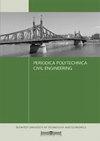Effect of Activator Type on Geopolymer Mortars Containing Different Types of Fly Ash
IF 1.4
4区 工程技术
Q3 ENGINEERING, CIVIL
引用次数: 0
Abstract
In this study, the influence of the activator type on the physical and mechanical properties of the geopolymer mortars was analyzed. C and F-class fly ash (FA), blast furnace slag (BFS), sodium hydroxide (NH), sodium metasilicate (NS), standard sand, and distilled water were used in the production of mortar specimens. All specimens were cured at room temperature. C and F-class fly ash usage ratios are 0%, 15%, and 30%. NH was used as an activator in the 1st group of the produced geopolymer mortars, and NS with NH was used in the 2nd group. 5 series were produced and a flow-table test, ultrasonic pulse velocity test, flexural strength test, compressive strength test, and Scanning Electron Microscope-Energy Dispersive Spectrometry (SEM-EDS) microstructure analysis were applied to the samples. The addition of NS increased the compressive strength and the greatest increase occurred in the reference sample by 113%. It also increased the compressive strength of FAF30 by 60% in comparison to FAC30. Following the results of the SEM examination, when the reference samples were compared, the addition of NS inhibited the formation of cracks. According to the SEM-EDS analysis results, an increase in the F and C-class FA ratio improved the crack formation. Compared to F-class FA, FAC30 has more cracks due to the lower SiO2 content in C-class FA. High K content and SiO2 ratio, as determined by EDS analysis, boost the alkalinity and positively impact the strength.活化剂类型对不同粉煤灰掺量地聚合物砂浆的影响
本研究分析了活化剂类型对地聚合物砂浆物理力学性能的影响。砂浆试样采用C、f级粉煤灰(FA)、高炉矿渣(BFS)、氢氧化钠(NH)、偏硅酸钠(NS)、标准砂和蒸馏水。所有标本均在室温下固化。C级、f级粉煤灰用量分别为0%、15%、30%。所制地聚合物砂浆第一组用NH作为活化剂,第二组用含NH的NS作为活化剂。制作了5个系列,并对样品进行了流表试验、超声脉冲速度试验、弯曲强度试验、抗压强度试验和扫描电镜-能谱(SEM-EDS)显微结构分析。NS的加入提高了试样的抗压强度,其中基准试样的抗压强度增幅最大,达到113%。与FAC30相比,它还使FAF30的抗压强度提高了60%。根据SEM检查结果,当对照样品时,添加NS抑制了裂纹的形成。SEM-EDS分析结果表明,F级和c级FA比的增加促进了裂纹的形成。与f级FA相比,由于c级FA中SiO2含量较低,FAC30的裂纹较多。能谱分析表明,高钾含量和高SiO2比提高了碱度,对强度有积极影响。
本文章由计算机程序翻译,如有差异,请以英文原文为准。
求助全文
约1分钟内获得全文
求助全文
来源期刊

Periodica Polytechnica-Civil Engineering
工程技术-工程:土木
CiteScore
3.40
自引率
16.70%
发文量
89
审稿时长
12 months
期刊介绍:
Periodica Polytechnica Civil Engineering is a peer reviewed scientific journal published by the Faculty of Civil Engineering of the Budapest University of Technology and Economics. It was founded in 1957. Publication frequency: quarterly.
Periodica Polytechnica Civil Engineering publishes both research and application oriented papers, in the area of civil engineering.
The main scope of the journal is to publish original research articles in the wide field of civil engineering, including geodesy and surveying, construction materials and engineering geology, photogrammetry and geoinformatics, geotechnics, structural engineering, architectural engineering, structural mechanics, highway and railway engineering, hydraulic and water resources engineering, sanitary and environmental engineering, engineering optimisation and history of civil engineering. The journal is abstracted by several international databases, see the main page.
 求助内容:
求助内容: 应助结果提醒方式:
应助结果提醒方式:


